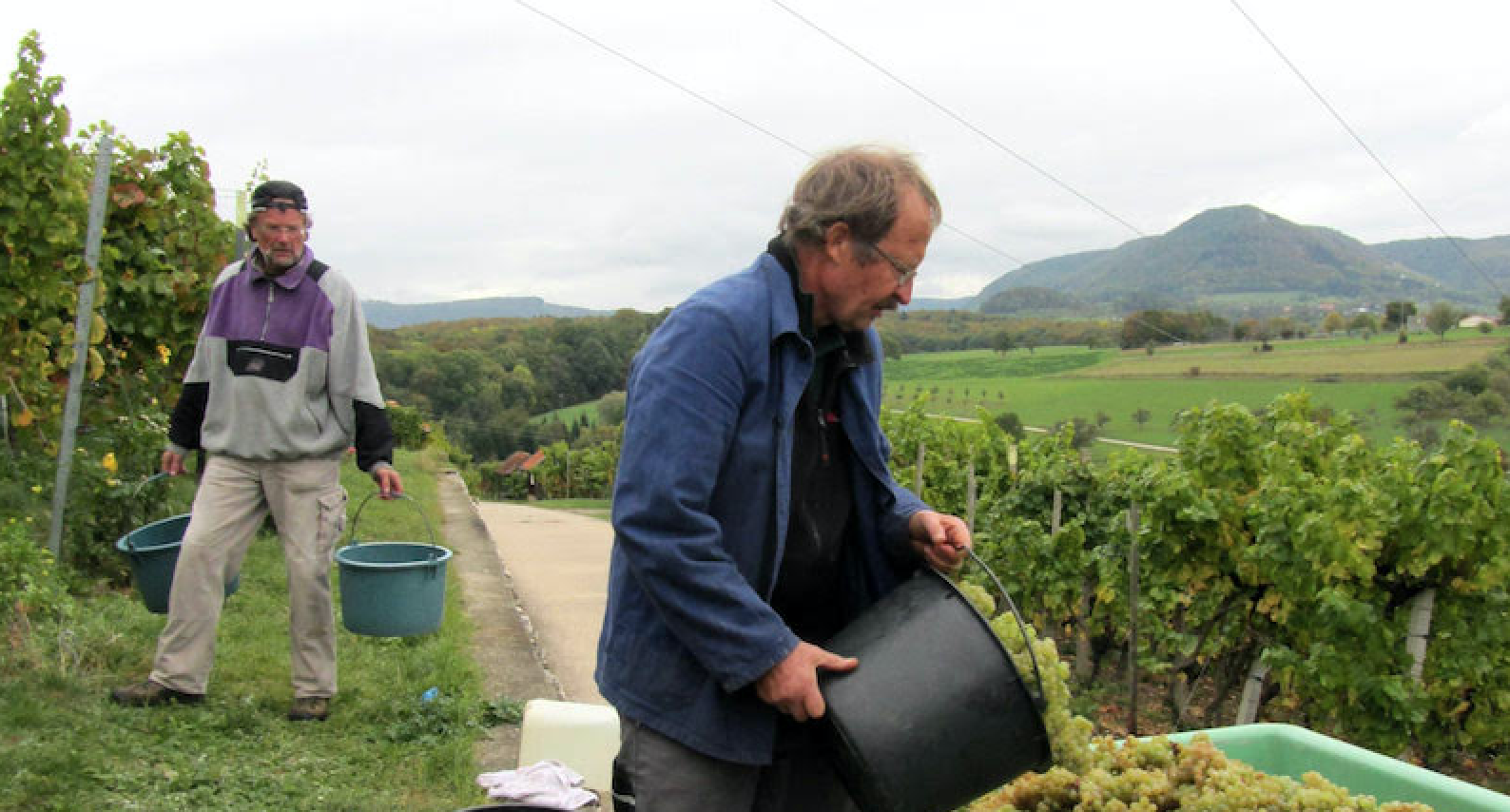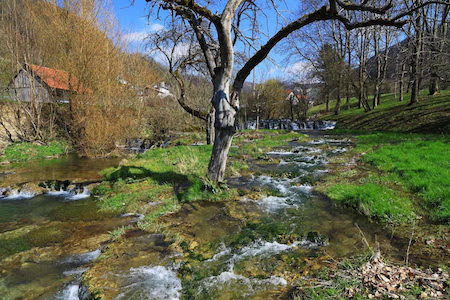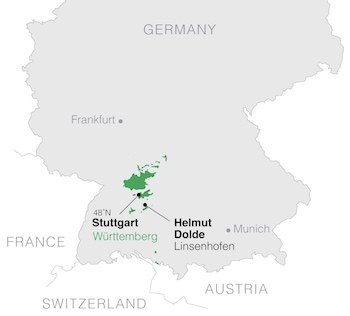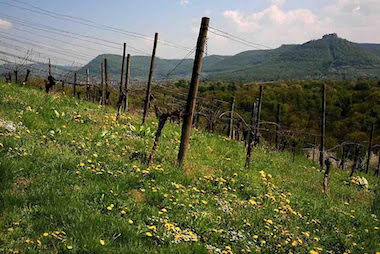
Around the tiny village of Linsenhofen that winemaker Helmut Dolde and his wife, Hedwig, call home, the terrain of Württemberg shifts. The hills climb higher and steeper. The climate cooler. The soils more calcareous and volcanic. This is the edge of a region known to English-speakers as the Swabian Alps or Swabian Jura. To the Germans, it is the Schwäbische Alb, a name taken from Suebi, an ancient Germanic tribe, and Alpis, a Celtic word meaning “nurturing mountain.” It’s a remote-feeling place of forests, cliffs, mountains, and streams that draws hikers and spa-goers — not, generally, wine lovers.
 Dolde makes a quiet but compelling case that this should be otherwise. This is the terroir of what he calls his Bergweine, mountain wines. Dolde's 2.5 hectares of vineyards include some of the highest in Germany, pushing more than 500 meters [1,600 feet] above sea level. The wines are, above all, liquid expressions of “the freshness and clearness of our high altitudes,” as he sees it. They reflect the trial-by-error experience of nearly 40 vintages, a distillation of responsiveness over dogma, observation over received wisdom, thoughtful farming, low-tech cellar work, and a profound respect for both process and precision. Working with an array of Germanic and Burgundian varieties, especially Riesling, Silvaner, Weißburgunder (Pinot Blanc) and Spätburgunder (Pinot Noir), in the cool sites and specific soils of Swabia, Dolde's skill is to reveal nuances of these varieties we might otherwise never have known were there.
Dolde makes a quiet but compelling case that this should be otherwise. This is the terroir of what he calls his Bergweine, mountain wines. Dolde's 2.5 hectares of vineyards include some of the highest in Germany, pushing more than 500 meters [1,600 feet] above sea level. The wines are, above all, liquid expressions of “the freshness and clearness of our high altitudes,” as he sees it. They reflect the trial-by-error experience of nearly 40 vintages, a distillation of responsiveness over dogma, observation over received wisdom, thoughtful farming, low-tech cellar work, and a profound respect for both process and precision. Working with an array of Germanic and Burgundian varieties, especially Riesling, Silvaner, Weißburgunder (Pinot Blanc) and Spätburgunder (Pinot Noir), in the cool sites and specific soils of Swabia, Dolde's skill is to reveal nuances of these varieties we might otherwise never have known were there.
(Photo, above: The idyllic landscape of the Schwäbische Alb.)
The wines are all the more extraordinary for being the product of a 67-year-old high school chemistry and biology teacher with no formal training as a winemaker. Nearly four decades ago, Dolde began to apply his scientific mind to wine growing and making. He taught himself from books, questioned colleagues, and made his own close study of soil, climate and variety. In conversation, Dolde unpacks the intricacies of winemaking piece by piece, with a good teacher’s eagerness to instruct, but first to connect.
It’s easy to imagine Dolde in a classroom, sharing his enthusiasms, engaging with students, learning as much as teaching. “School was very important for me. A fine job: you always work with young people and you are always up to date with the youngsters. Winemaking is my hobby. But you can also see it otherwise. Winemaking is my job and school is my hobby. I have tried to make both in the same quality.” To taste his wines is to realize how lucky his students have been.
 Dolde’s family settled in Linsenhofen, less than 30 miles southeast of Stuttgart, generations ago. Though he moved around a bit early on, in 1981 he and Hedwig settled back in the village to raise their four children. “I started promptly with winegrowing as a hobby,” says Dolde. “My parents owned a very small vineyard of Silvaner, but sold the grapes” — per local custom. “My wife and I took the vineyard and tried to make wine. I experimented with a 50-liter glass demijohn over two years. One year we could drink it, the other year we poured it out,” he laughs.
Dolde’s family settled in Linsenhofen, less than 30 miles southeast of Stuttgart, generations ago. Though he moved around a bit early on, in 1981 he and Hedwig settled back in the village to raise their four children. “I started promptly with winegrowing as a hobby,” says Dolde. “My parents owned a very small vineyard of Silvaner, but sold the grapes” — per local custom. “My wife and I took the vineyard and tried to make wine. I experimented with a 50-liter glass demijohn over two years. One year we could drink it, the other year we poured it out,” he laughs.
To improve, says Dolde, “I read a lot. I visited symposia. I tried to get good contact to an enologist. I asked colleagues — but, you know, if you ask a colleague, they don't tell you everything — it’s capital. But if you talk with ten people, everybody talks a little bit, you put the parts together like a puzzle, and you learn that way.”
“We are a little bit isolated here, not in the center of a big wine growing region. So it’s necessary to look beyond our village, to drink wines from other places — a very important and fun point of learning. I’ve always enjoyed drinking wines analytically, making comparisons. I ask myself why this wine tastes like this, the other like that.”
What he has learned comes down to this: “All that I can bring to the glass must be grown in the vineyard. I cannot develop more. If I did good work in the vineyard, I have a big range of possibilities. The art of winemaking is to lose less of these possibilities.”
“Vine growing has a very long tradition here,” he explains. “We know this ground has been giving wine for over a thousand years. It must be very tired.” His aim is to work the land in a way that leaves it “at a minimum in the same condition, but better, in a better condition than I had it.” To this end, he experiments with soil treatments that do the least harm, avoiding treatments such as copper sulfates, which, though accepted as "organic," have effects that are coming under increasing scrutiny from thoughtful growers. Beyond this, Dolde keeps his soils vital by balancing a mix of cover crops and erosion protection measures, both necessary in the widening extremes of drought and deluge that accompany climate change.
 Most crucially, Dolde simply allows nature to proceed with its own inclination to diversity. Streuobstwiesen, or meadow orchards — groves of fruit trees open to community use — dot the landscape around Linsenhofen and were once typical of many parts of Europe. Cherry, peach, and plum trees, as well as extremely rare local varieties such as the Black Pear, survive here, some a century old. Dolde believes that turning the fruit of these trees into traditional apple and pear wines as well as a range of distillates, he contributes to the preservation of a unique cultural and natural landscape, supports a fading form of communal agriculture, and maintains a living link to past traditions. (A portion of the sale of Dolde’s products goes to the Swabian Alp Biosphere Area, a UNESCO initiative that essentially shares his aims).
Most crucially, Dolde simply allows nature to proceed with its own inclination to diversity. Streuobstwiesen, or meadow orchards — groves of fruit trees open to community use — dot the landscape around Linsenhofen and were once typical of many parts of Europe. Cherry, peach, and plum trees, as well as extremely rare local varieties such as the Black Pear, survive here, some a century old. Dolde believes that turning the fruit of these trees into traditional apple and pear wines as well as a range of distillates, he contributes to the preservation of a unique cultural and natural landscape, supports a fading form of communal agriculture, and maintains a living link to past traditions. (A portion of the sale of Dolde’s products goes to the Swabian Alp Biosphere Area, a UNESCO initiative that essentially shares his aims).
(Photo, above: Flowering pear trees.)
Dolde’s holdings encompass a vibrant and interdependent mix of orchards, forest, and vines. Because Dolde taught full time until two years ago, he could only cultivate a third of the grapes he works with. The rest he sources from parcels worked by “three young men I have selected who have great hands, who are very responsible and environmentally conscious,” and with whom he works closely on cultivation and harvesting decisions. “We go through the vineyards. We discuss. I learn from them, they from me. It’s an exchange. Together, we produce the best possible grapes. Then, after harvest, the grapes are totally in my cellar and I make the wine.”
While many of the best sites in Württemberg are planted to the region’s flagship red grape, the prolific Trollinger, the variety was never part of Linsenhofen's landscape. It is simply too cool here. “The tradition of our region is Silvaner,” Dolde explains. “But nobody loves it because it produces a lot of quality, not quantity and people were always concerned about kilograms. Silvaner is very difficult to cultivate. It is easier to work with other grapes.”
 Dolde is drawn to Silvaner because of its roots here and its capacity to express the cool, sylvan qualities of the Swabian Alb. Because he works on such a small scale, in such a hands-on style, he can preserve the most fragile qualities of his grapes. It's quite possible the reason Silvaner has long been ignored is that no one was listening closely enough to what it was trying to say. Dolde listens, intently.
Dolde is drawn to Silvaner because of its roots here and its capacity to express the cool, sylvan qualities of the Swabian Alb. Because he works on such a small scale, in such a hands-on style, he can preserve the most fragile qualities of his grapes. It's quite possible the reason Silvaner has long been ignored is that no one was listening closely enough to what it was trying to say. Dolde listens, intently.
(Photo, right: Silvaner grapes at full ripeness.)
He also pays scrupulous attention to geology. The Swabian Alps are an extension of the Swiss Jura formation. What makes them so distinctive for wine is the presence of Jurassic soils that, according to Dolde, have long since eroded from nearly all other German vineyard areas.
During the Jurassic period, beginning some 200 million years before the present, thick sedimentary layers were deposited at the bottom of a sea that, over eons, reached tropical temperatures. In the subsequent Cretaceous era, massive erosion, and in the Tertiary, volcanic activity, shaped the unique geology and topography of the area.
Geologists distinguish among the Jurassic layers, separating (for our purposes) the Brauner Jura of the middle period from the Weißer Jura of the upper, or more recent. Brauner Jura is a band of clay-rich brown marl. Weißer Jura is a more calcareous marl (known in Burgundy as marne blanche) formed by the corals and marine life that thrived in the sea when it warmed enough to support them, toward the end of the Jurassic. Brauner Jura, interspersed with pockets of dark, mineral-rich volcanic soils, forms the basis of the Linsenhofen vineyards, while parcels in neighboring Neuffen and Beuren have their roots in Weißer Jura. (Dolde uses the name Jurakalk for wines grown on both layers.)
 Dolde explains that wines grown on Weißer Jura benefit both from the Chablis-like fossilized marine-based soils and the higher altitude of the parcels, which sit some 150 meters (nearly 500 feet) above the Brauner Jura plots in Linsenhofen. “The higher altitude with cool nights conserves acidity. The wine is fresher, more fruity in its aromatics, cool and crisp,” he says. The Brauner Jura wines, grown at lower elevation, with slightly warmer nights and darker, heat-retaining soils, are, he says, “more full bodied, more harmonic in their acidity.”
Dolde explains that wines grown on Weißer Jura benefit both from the Chablis-like fossilized marine-based soils and the higher altitude of the parcels, which sit some 150 meters (nearly 500 feet) above the Brauner Jura plots in Linsenhofen. “The higher altitude with cool nights conserves acidity. The wine is fresher, more fruity in its aromatics, cool and crisp,” he says. The Brauner Jura wines, grown at lower elevation, with slightly warmer nights and darker, heat-retaining soils, are, he says, “more full bodied, more harmonic in their acidity.”
“Romanée-Conti, Montrachet could be here,” Dolde contends. “We have the same geology as Burgundy, exactly the same geologic layer. You can find the same fossils. You can find the same plants. If you take a mirror, it's one to one.” One reason you’ve heard of Montrachet, not Linsenhofen, is climate. “We are more north and we are higher,” Dolde explains. “We are the cool Burgundy. But, perhaps the Burgundy of the future,” he says, a smile coming into his voice.
Although Dolde favors varieties distinct to the Swabian Alp, the Burgundy connection prompted him to try his hand at Pinot Noir. He realizes that Chardonnay “would perhaps be possible, but our Silvaner, with its freshness in the very cool climate and its tradition in the area, I think makes a very good alternative. And my idea is not to copy, but to develop the speciality for our region. I want to test the possibilities.”
There is no doubt that climate change will force winemakers to test plenty of possibilities. Weather extremes, especially episodes of drought and heavy rainfall that can set up conditions for steep-slope erosion, are now more present risks for Dolde. On the flip side, the very near-term benefits include longer growing seasons, especially for varieties with protracted vegetation cycles that once struggled here.
“This is a theme for Württemberg,” Dolde asserts. “Varieties like Pinot Noir, Silvaner, Riesling, Weißburgunder come to their optimum ripeness nowadays, which they did not 30 years ago. The new climate gives us both very good quality and yields.” Because this climate transition has occurred over the course of Dolde’s careful watch, he has been able to evolve his farming and winemaking in response — and, so far, to benefit from it. “Now, in spring, we’ve just bottled the 2018s. I think it’s the best year we’ve ever had for white and red. I am very happy. It was a warm year, with enough rain, without disease pressures. No one could believe we could get a good wine in the heat and the dryness. But at the end of the year, with a long vegetation period, we harvested a big yield. I think the wines will have a little more body, but with good freshness.”
Dolde’s small, old-school cellar keeps him intimately engaged with the wines from the moment the grapes arrive from the vineyard. Initially, this was by necessity. “We have very little technology. We have no pumps. We work totally by hand. At first, we were too small and we had no money to buy equipment. I thought, ‘What a shame, but we can’t do anything else.’ In the meantime, this is a very big point for quality. All I do is to steer the wines to develop in a special direction, to come to an interesting type of wine.”
The cellar work starts with the grapes coming in “very, very cold, picked with the rising sun,” because Dolde has no cooling technology and low fermentation temperatures are essential to his Bergwein style. “I use old bedsheets, wet with water, and a big fan to cool my wines,” a method that appears to give Dolde surprisingly nuanced control. “This is very critical because if the temperature of the fermenting wine grows, some aromas have a very low temperature at which they distillate out.”
Although Dolde prefers spontaneous fermentation where possible, he is pragmatic. “As with many things, you should not go dogmatic here. If the grapes are healthy, if there has not been too much rain before harvest, and if the harvesting temperatures are low, then these are ideal conditions for spontaneous fermentation. In other cases, fermentation with a selected-from-nature, pure-breeding yeast may be more advantageous. But here you can optimize the result. I would not ferment a wine in one large tank with one yeast, but distribute the juice over 10 small containers and ferment each with its own, different yeast. Even so, I come to more complexity if I then merge the wines later. That makes more work, but the result is clearly better. In 2018, we had perfect conditions, so all wines are spontaneous. In 2017, most were.”
He is convinced that the “grows together goes together” concept extends to fermentation and aging vessels, especially for his Pinot Noirs. “The idea is if you use a cask, you make aromatization. The best will be if I use wood grown on the same terroir. It makes no sense to buy tonneau in France and store our Swabian Alp Bergweine in French wood.” A local cooper makes Dolde’s casks from wood they select in nearby forests. “The wood is sawn and put out in the fresh air and rain to wash out the aggressive tannins. Also, there’s a microbiological fermentation that takes place in the wood. Oak varies, depending on the soil influences, the type of extractable molecules in the wood. Our oaks give a very gentle character to our wines.”
He ages and ferments most of his whites in stainless steel. “For my taste, the risk of wood is to make the wine too heavy, full, warm. That’s just the opposite of what I want. But if I have 10%, 15% of wood-fermented wine blended with INOX wine, I get a little bit of length, more pressure on the tongue and I don't lose freshness.”
 It’s easy to sense the satisfaction Dolde gets from refining his understanding and technique vintage after vintage. “Every year is a new experiment in my mind,” explains Dolde. “You have the grapes and the vineyard for a year, and you make the wine and you drink it. In two years, you get your results.” His joy in experimentation comes through in the range of wines he makes, impressively diverse for a one-man operation: monovarietal, soil-specific Riesling, Silvaner, Pinots Noir and Blanc sit side by side with sparkling wines of pear and apple, a méthode champenoise blanc de noir joins a new this year pet-nat of Silvaner and Weißburgunder.
It’s easy to sense the satisfaction Dolde gets from refining his understanding and technique vintage after vintage. “Every year is a new experiment in my mind,” explains Dolde. “You have the grapes and the vineyard for a year, and you make the wine and you drink it. In two years, you get your results.” His joy in experimentation comes through in the range of wines he makes, impressively diverse for a one-man operation: monovarietal, soil-specific Riesling, Silvaner, Pinots Noir and Blanc sit side by side with sparkling wines of pear and apple, a méthode champenoise blanc de noir joins a new this year pet-nat of Silvaner and Weißburgunder.
(Photo, right: For Dolde, the communion of harvest is an integral part of the ritual.)
“The quality of my wine has improved every year,” Dolde reflects, “because I got more experience, more knowledge. Every year is a new experiment. This is a chance for development.” But there is a strong sense that what brings Dolde back to the vineyard year after year is, in fact, human connection and friendship. He has a profound affection for the ritual of harvest. “There are a lot of friends. I phone or send an email, and it is with great respect and joy that we meet and work for some hours together. We talk a lot. We have a good meal. It's like a meditation. It's very communicative. All my friends like this. It’s always the same, over long years now.”
Photographs: Dieter Ruoff
Map: wingdesignstudio.de
This is the third in a series of articles on the recent rise of the wines of Württemberg. For more, check out Valerie Kathawala's piece on Jochen Beurer and her interview with Olympia Samara and Johannes Hoffmann of Weingut Roterfaden.










